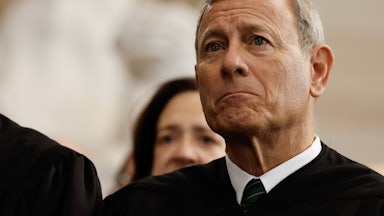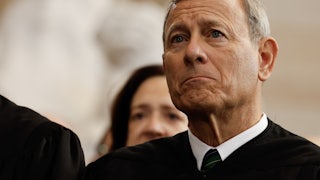Mikie Sherrill should have this in the bag. Right?
The Democratic nominee for governor in New Jersey has represented a suburban district in the U.S. House since 2019. A moderate and a veteran, she is well positioned to win back voters who have voted Republican in recent elections, particularly the surprisingly close 2021 gubernatorial race and the 2024 presidential race, when Donald Trump garnered 46 percent of the vote in a state that hasn’t gone red in almost 40 years. No one could accuse Sherrill of being woke or a Communist; she is different in most respects from Zohran Mamdani, the Democratic socialist who is poised to become New York City’s next mayor. And, perhaps most importantly, the president is very unpopular, which should be a drag on Republican candidates.
So it should be a very good time to be a seasoned Democrat running for statewide office in a blue state—but maybe not in New Jersey.
Despite the aforementioned litany of advantages, Sherill is running neck-and-neck with Jack Ciattarelli, a pro-Trump politician who narrowly lost the last gubernatorial election to Democrat Phil Murphy, who is term-limited. Why is the race so close? New Jersey, ever the outlier, is just a little bit different from its Northeastern brethren. Trump is not quite as unpopular there (he has a 41 percent approval rating, six points higher than Murphy’s), and Ciattarelli has run a disciplined campaign, keeping the president close—but not too close to alienate the moderate and swing voters he needs to win. The result is a perilous situation for Democrats. Not only could they lose control of a crucial state, but doing so would raise troubling questions about the health of the party heading into the 2026 midterm elections.
“I think you saw the beginnings of this in ’21. There’s a frustration by voters in New Jersey on economic stuff, on crime issues, and I also think there’s an underbelly in the stuff Trump tapped into culturally,” Republican strategist Chris Russell, who advises Ciattarelli, told Politico after Trump did surprisingly well in the state last fall. “People are tired of being told they’re bad people, racists, bigots or Nazis—all these crazy aspersions that are cast on people who support Trump or things that he believes.”
That populist anger is driving Ciattarelli’s campaign, though he has spun it into a potent message in the Garden State. “There’s a New Jersey I want to get back to,” he said in a typical stump speech. “I grew up in a time when my parents didn’t have to worry about me walking to the bus stop. My parents didn’t have to worry about what I was learning at school that day.” Ciattarelli’s message is like a GOP-ified version of Mamdani’s. He talks incessantly about affordability, but he’s more likely to blame high energy costs and property taxes—the real culprit being the Democratic Party, which has run the state since Chris Christie left office in 2018.
Sherrill, meanwhile, has struggled to break through. She is a safe candidate—someone who doesn’t excite progressives but who also has struggled to win over moderates skeptical of giving Democrats another four years in charge. She is far from an expert communicator, with a tendency toward complex, winding answers and statements that Ciattarelli has seized on as proof that she doesn’t really have a plan to govern the state. Here, for example, is a typical quote she gave to Michael Kruse for his excellent piece on the race in Politico:
I want you to know something. We’ve got challenges ahead, we’ve got hard times, we’ve got a lot of work to do—but I want you to know something in your heart as we’re going through these struggles, as we’re making sure we’re taking care of our families, as we’re thinking about each other and how we’re going to care for our state, the community members that we care about.
Her campaign is also rooted in affordability concerns, but she is in a difficult position for any politician, even one more rhetorically gifted than she. Murphy has led the state since 2019, and voters are now wary of Democratic promises and increasingly looking to Republicans for change. It’s not so different from the environment that swept Chris Christie into office back in 2010.
2010 was, of course, the high-water mark of the Tea Party—change was in the air everywhere. Now the national energy is the opposite. It’s Democrats who are furious and want candidates who can fight Trump’s incursions into their backyard.
This is a gift for Sherrill—if she wins, it will almost certainly be because national concerns triumphed over more local ones for many voters—but it’s one that she’s struggled to capitalize on. Her ads have labeled Ciattarelli “Trump in Trenton” and, in their final debate, she hammered him for being “100 percent MAGA.” It’s an argument that should be easy to make. New Jersey has suffered during the government shutdown; Office of Management and Budget chief Russ Vought axed $18 billion in funding for the Gateway tunnel project, which would ease commuting between New Jersey and New York City. And, of course, there’s the general lawlessness and authoritarianism of the current administration—particularly when it comes to immigration.
Sherrill has tried to craft a message that appeals to those who are concerned about Immigration and Custom Enforcement’s growing power and lawlessness without sacrificing her moderate image. It’s a balancing act she has struggled with throughout the election. She has tended toward fairly safe (and fairly ineffectual) policy positions, like supporting a ban on ICE agents using face coverings, while saying as little as possible about her position on a state directive that prohibits local and state law enforcement from cooperating with federal immigration agents. “My position has always been to make sure that here in New Jersey we’re following the law and the Constitution,” Sherrill told reporters after a September debate. “I’ve always been a supporter of comprehensive immigration reform.” It’s a position that has left those on both sides of the issue frustrated.
This race has serious implications for Democrats as they head toward next year’s midterms. It suggests that safe, moderate, milquetoast candidates may not be enough—even if they have all the right items on their résumés—if they can’t communicate effectively with voters. More troublingly, it suggests that voters are still frustrated with Democrats and that anger and dissatisfaction at Trump may not be enough to win in some cases. When you compare Sherrill’s stumbling performances to that of Mamdani in New York City—who is not exactly a favorite of the Democratic powerbrokers who adore Sherrill—it also suggests a candidate selection problem. The people running the Democratic Party don’t seem to have a handle on what voters are looking for.
The rest of America is not New Jersey, of course—for better or for worse. Many other Democrats won’t face the specific problems Sherrill is facing. Narrowly leading in the polls, she may yet eke out a victory. But even if she does, there will be the lingering sense that her party hasn’t learned anything in the last year.










